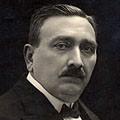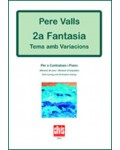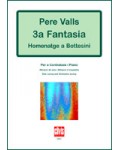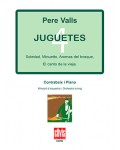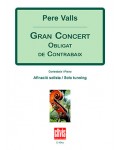
No products
Prices are tax included
Product successfully added to your shopping cart
There are 0 items in your cart. There is 1 item in your cart.
- English
- Castellano
- Català
Pere Valls i Duran was born in Sabadell (Barcelona) in the year 1869, and died in the Catalan capital in 1935. He was an outstanding double-bass player and composer and an excellent double-bass teacher. He began his musical studies in Sabadell, but later moved to Barcelona to extend them. At the age of eighteen, already with a good command of the double bass, he travelled to the Republic of Argentina, where he established himself in Buenos Aires, and formed part of several orchestras. There, he was able to extend his studies of harmony and counterpoint, as well as the double bass, with José Roveda, pupil of the great Italian double bass player Giovanni Bottessini. The experience he gained in Buenos Aires, both with symphonic and operatic repertoires, was decisive in his career. The American phase ended in 1892 when, due to family circumstances, he had to return to Catalonia.
That same year he settled in Barcelona and, throughout the following 30 years, he was one of the most outstanding artists on the Catalan music scene, because of the significant roles he played in four areas: in the first place, as an performer - he was part of the best orchestras of the time, such as the Orchestra Pau Casals, Barcelona’s City Band and the Orchestra of the Gran Teatre del Liceu; secondly, as a double bass teacher - he was a teacher at the Liceu Conservatoire for more than 20 years, and the majority of the country’s double bass instrumentalists passed through his classes. In addition, he was the author of a Method for the Double Bass, indebted to the Bottessini School; thirdly, through his work in promoting music, by actively participating in different musical associations like the Musicians’ Union of Catalonia, the Barcelona Wagnerian Association or the Workers’ Concert Association; and, fourthly, as a composer.
As a composer, Pere Valls was the author of more than fifty works for various groups, but, of all of them, those for the double bass are outstanding. From among his works for the double bass and piano, we highlight the Andalusian Suite (1918) in four movements. It is a work which is currently included in the repertoire of several European double bass schools, such as Madrid’s Reina Sofia department. Other remarkable works are the three Fantasias for double bass and orchestra (written between 1894 and 1917), one of which is a tribute to Bottessini; the Grand obligatory concerto for double bass (1906), the Fantasia andante with variations, the Grand Introduction and Tarantella, the Theme with variations for the double bass, the Tarantella-concerto for double bass (1893) and the Romance for double bass and piano, a work which - in its transcription for the cello - was played for the first time by Pau Casals himself. His catalogue is completed with works for orchestras, piano, chamber orchestras, the cobla (a wind orchestra popular in Catalonia), for bands, solo instruments, dance bands and, finally, a zarzuela (Spanish operetta).
-
2a fantasia
Edition: DigitalThe Second Fantasy by Pere Valls the genre of eshowcase piecef perfectly and is structured around one theme and two variations.
10,47 € -
2a fantasia
Edition: PrintedThe Second Fantasy by Pere Valls the genre of eshowcase piecef perfectly and is structured around one theme and two variations.
18,00 € -
-
3a fantasia: Homenatge a Bottesini
Edition: DigitalThe Third Fantasy by Pere Valls is a show piece which combines virtuosistic fragments with soaring lyrical passages; a waltz theme emerges after the introduction, and the central section is structured around three variations on a theme.
12,10 € -
4 juguetes
Edition: DigitalThe work 4 juguetes by Pere Valls was written in 1912, consisting of an Andalusian Caprice entitled Soledad (Solitude), a Minuet, a Gavotte Caprice, with the title Aromas del bosque (Aromas of the forest) and ending with El canto de la vieja (The song of the old woman), subtitled Catalanesca.
12,10 € -
-
-
4 juguetes
Edition: DigitalThe work 4 juguetes by Pere Valls was written in 1912, consisting of an Andalusian Caprice entitled Soledad (Solitude), a Minuet, a Gavotte Caprice, with the title Aromas del bosque (Aromas of the forest) and ending with El canto de la vieja (The song of the old woman), subtitled Catalanesca.
12,10 € -
Gran concert obligat de contrabaix
Edition: DigitalThe Great Forced Concert of Doublebass is divided into three parts, Allegro moderato, Barcarola and Scherzo finale, and allows a great brilliance of the performer either on piano version or orchestra version.
13,38 € -
Gran concert obligat de contrabaix
Edition: DigitalThe Great Forced Concert of Doublebass is divided into three parts, Allegro moderato, Barcarola and Scherzo finale, and allows a great brilliance of the performer either on piano version or orchestra version.
13,38 € -
Gran concert obligat de contrabaix
Edition: DigitalThe Great Forced Concert of Doublebass is divided into three parts, Allegro moderato, Barcarola and Scherzo finale, and allows a great brilliance of the performer either on piano version or orchestra version.
21,81 € -

